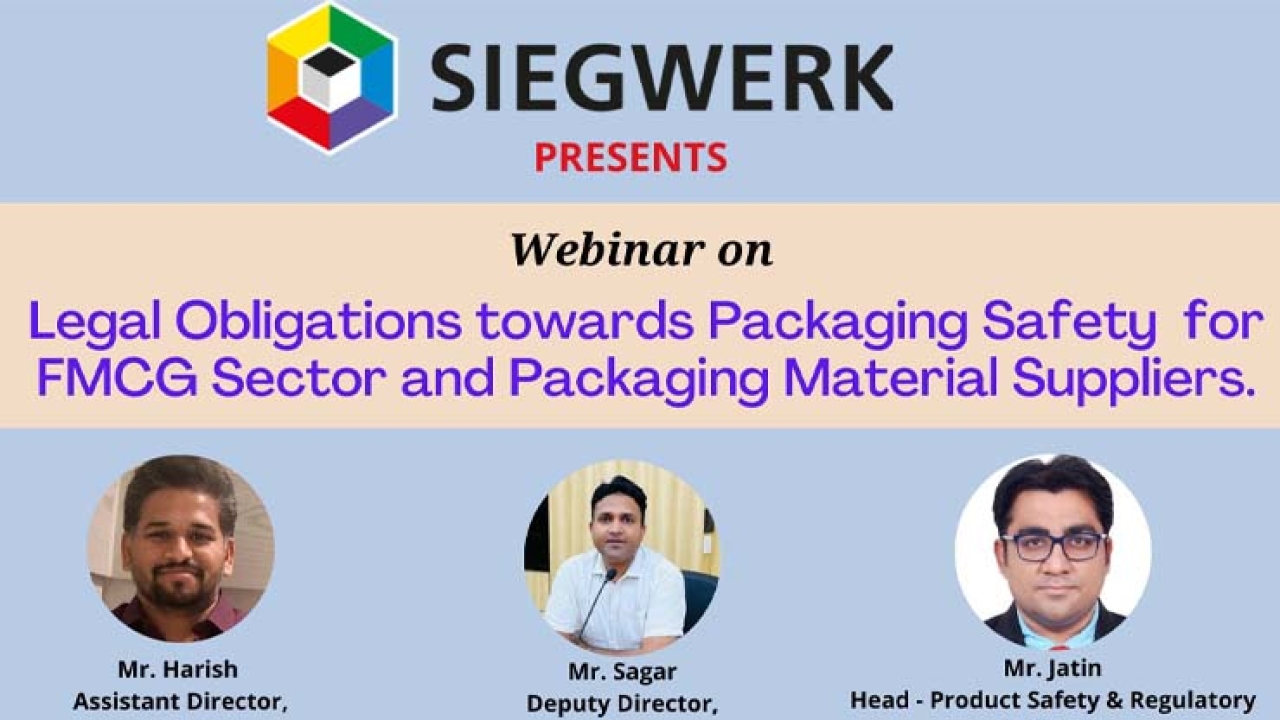Siegwerk hosts webinar on packaging safety obligations
Siegwerk has conducted a ‘Legal obligations towards Packaging Safety for FMCG Sector and Packaging material suppliers’ session, attended by 300 participants and followed by a detailed Q&A session.

The session included expert speakers from Food Safety and Standard Authority of India (FSSAI), Bureau of Indian Standards (BIS) and Siegwerk, to provide clarity on the legal obligations for FMCG sector and associated packaging suppliers.
FSSAI has raised the bar on packaging safety recent food packaging regulations. The BIS has revised the standard IS 15495. Siegwerk made a sincere attempt to create the awareness in market with support from the Food Safety and Standard Authority of India as well as Bureau of Indian Standards.
Harish Kumar R.K, assistant director, Science and Standard Division (FSSAI) mentioned that industry has not been focused on the safety aspects of the packaging/packaging material. For this reason, there were concerns and this were addressed by FSSAI and for the same reason the FSS (Packaging & Labelling) Regulation, 2011 was split into Packaging Regulation (in effect since 2019), Advertisement & Claim regulation and Labelling & Display regulation.
The FSS (Packaging) regulation was notified on December 24, 2018 and enforced from July 1, 2019. FSSAI regulation is mandatory for the Food Business Operators (FBO’s) and manufacturer of materials to ensure compliance. Kumar RK spoke on the regulation and material wise requirements for paper & board, glass, metal & metal alloys, plastics. In the regulation, definition of food grade has been incorporated; inks have been regulated as per IS 15495. Recent amendment on use of recycled plastics in food packaging (which is currently only limited to rPET) and the process around the approval of use of recycled plastics were also discussed.
Sagar Singh, deputy director of chemical division of BIS, mentioned that the standard IS 15495, now mandated by FSSAI is created by BIS. Printing inks are the next big issue in sustainable packaging.
The standard IS 15495 was revised by incorporating chemicals such as toluene and certain phthalates. Current ink standard is a negative list standard which restricts certain chemicals in ink formulations.
BIS endeavors to adopt a positive list that includes non-hazardous chemicals. The IS 15495 standard is being updated to include of mineral oil and Cobalt carboxylates in Annex- A , Xylene and Methylcyclohexane in film printing of food packaging, some photo initiators in Annex- A. BIS is also developing a new standard on eco-friendly inks.
BIS has launched Standardization Module to provide comments on standards, provision to become member in standard committee.
Jatin Takkar, head of product safety and regulatory at Siegwerk India spoke about the implementation of packaging safety to ensure consumer safety. Ensuring packaging safety includes regional regulations and brand owner requirements, complex packaging supply chain as well as manufacturer commitments. Regional regulations are different in terms of their structure and associated details and are further supplemented by the brand owner requirements which makes it complex for supply chain to ensure compliance.
The regulatory status of the chemicals may change over time and needs to be mitigated by the commitment from the manufacturer. And finally, the complex packaging chain with multiple stakeholders, some with expertise on chemicals safety while others with expertise on food safety.
Packaging safety can be ensured by:
- Developing understanding of packaging safety and associated legal obligations
- Developing capabilities for creating specifications and performing risk assessment
- Promoting transparency and Integration across the supply chain
- Developing systematic processes and mechanisms around right vendor selection.
- Deploying the monitoring as well as the auding protocols
He mentioned that currently certifications/self-declarations issued by the manufacturers are not adequate to demonstrate the compliances however are well accepted by the brand owners due to limited understanding on packaging safety, associated legal obligations and systematic processes required to demonstrate the compliances. He shared examples of the correct certification methodology and explained all clauses.
Stay up to date
Subscribe to the free Label News newsletter and receive the latest content every week. We'll never share your email address.

